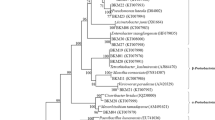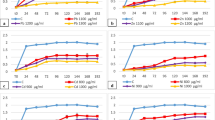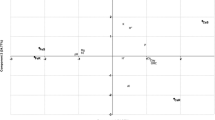Abstract
The aim of our work was the isolation and characterization of bacteria from the rhizosphere of Spartina maritima in the metal contaminated Odiel estuary (Huelva, SW Spain). From 25 strains, 84 % were identified as gram-positive, particularly Staphylococcus and Bacillus. Gram-negative bacteria were represented by Pantoea and Salmonella. Salt and heavy metal tolerance, metal bioabsorption, plant growth promoting (PGP) properties, and biofilm formation were investigated in the bacterial collection. Despite the higher abundance of gram-positive bacteria, gram-negative isolates displayed higher tolerance toward metal(loid)s (As, Cu, Zn, and Pb) and greater metal biosorption, as deduced from ICP-OES and SEM-EDX analyses. Besides, they exhibited better PGP properties, which were retained in the presence of metals and the ability to form biofilms. Gram-negative strains Pantoea agglomerans RSO6 and RSO7, together with gram-positive Bacillus aryabhattai RSO25, were selected for a bacterial consortium aimed to inoculate S. maritima plants in metal polluted estuaries for phytoremediation purposes.




Similar content being viewed by others
References
Abbas SH, Ismail IM, Mostafa TM, Sulaymon AH (2014) Biosorption of heavy metals: a review. J Chem Sci Technol 3: 74–102. https://www.researchgate.net/profile/Ibrahim_Ismail6/publication/268022877_Bisorption_of_heavy_metals_A_review/links/545f4a660cf295b56160e87b.pdf
Abdel-Baki AS, Dkhil MA, Al-Quraishy S (2011) Bioaccumulation of some heavy metals in tilapia fish relevant to their concentration in water and sediment of Wadi Hanifah, Saudi Arabia. Afr J Biotechnol 10: 2541–2547. http://www.ajol.info/index.php/ajb/article/view/93185
Ahemad M, Khan MS (2011) Functional aspects of plant growth promoting rhizobacteria: recent advancements. Insight Microbiol 1:39–54. doi:10.1016/j.jksus.2013.05.001
Amils R, Fernández-Remolar D, Parro V, Rodríguez-Manfredi JA, Timmis K, Oggerin M, Sánchez-Román M, López FJ, Fernández JP, Puente F, Gómez-Ortiz D, Briones C, Gómez F, Omoregie EO, García M, Rodríguez N, Sanz JL(2013) Iberian pyrite belt subsurface life (IPBSL), a drilling project of biohydrometallurgical interest. Adv Mater Res 825:15–18. doi:10.4028/www.scientific.net/AMR.825.15
Andrades-Moreno L, del Castillo I, Parra R, Doukkali B, Redondo-Gómez S, Pérez-Palacios P, Caviedes MA, Pajuelo E, Rodríguez-Llorente ID (2014) Prospecting metal-resistant plant-growth promoting rhizobacteria for rhizoremediation of metal contaminated estuaries using Spartina densiflora. Environ Sci Pollut Res 21:3713–3721. doi:10.1007/s11356-013-2364-8
Badri DV, Weir TL, Van der Lelie D, Vivanco JM (2009) Rhizosphere chemical dialogues: plant–microbe interactions. Curr Opin Biotechnol 20:642–650. doi:10.1016/j.copbio.2009.09.014
Bakker PA, Pieterse CM, van Loon LC (2007) Induced systemic resistance by fluorescent Pseudomonas spp. Phytopathology 97:239–243. doi:10.1094/PHYTO-97-2-0239
Barillot CDC, Sarde CO, Bert V, Tarnaud E, Cochet N (2013) A standardized method for the sampling of rhizosphere and rhizoplan soil bacteria associated to a herbaceous root system. Ann Microbiol 63:471–476. doi:10.1007/s13213-012-0491-y
Bhattacharyya PN, Jha DK (2012) Plant growth-promoting rhizobacteria (PGPR): emergence in agriculture. World J Microbiol Biotechnol 28:1327–1350. doi:10.1007/s11274-011-0979-9
Billi D, Potts M (2002) Life and death of dried prokaryotes. Res Microbiol 153:7–12. doi:10.1016/S0923-2508(01)01279-7
Burd G, Dixon DG, Glick BR (2000) Plant growth-promoting bacteria thatdecreases heavy metal toxicity in plants. Can J Microbiol 46:237–245. doi:10.1139/w99-143
Caçador I, Caetano M, Duarte B, Vale C (2009) Stock and losses of trace metals from salt marsh plants. Mar Environ Res 67:75–82. doi:10.1016/j.marenvres.2008.11.004
Cambrollé J, Redondo-Gómez S, Mateos-Naranjo E, Figueroa ME (2008) Comparison of the role of two Spartina species in terms of phytostabilization and bioaccumulation of metals in the estuarine sediment. Mar Pollut Bull 56:2037–2042. doi:10.1016/j.marpolbul.2008.08.008
Castagno LM, Estrella MJ, Sannazzaro AI, Grassano AE, Ruiz OA (2011) Phosphate-solubilization mechanism and in vitro plant growth promotion activity mediated by Pantoea eucalypti isolated from Lotus tenuis rhizosphere in the Salado River Basin (Argentina). J Appl Microbiol 110:1151–1165. doi:10.1111/j.1365-2672.2011.04968.x
Chun J, Lee JH, Jung Y, Kim M, Kim S, Kim BK, Lim YW (2007) EzTaxon: a web-based tool for the identification of prokaryotes based on 16S ribosomal RNA gene sequences. Int J Syst Evol Microbiol 57:2259–2261. doi:10.1099/ijs.0.64915-0
Couto T, Duarte B, Barroso D, Caçador I, Marques JC (2013) Halophytes as sources of metals in estuarine systems with low levels of contamination. Funct Plant Biol 40:931–939. doi:10.1071/FP12300
Danhorn T, Fuqua C (2007) Biofilm formation by plant-associated bacteria. Annu Rev Microbiol 61:401–422. doi:10.1146/annurev.micro.61.080706.093316
Dary M, Chamber-Pérez MA, Palomares AJ, Pajuelo E (2010) In situ” phytostabilisation of heavy metal polluted soils using Lupinus luteus inoculated with metal resistant plant-growth promoting rhizobacteria. J Haz Mat 177:323–330. doi:10.1016/j.jhazmat.2009.12.035
Das, N, GeetanjaliBasak LV, Salam JA, Abigail MEA (2012) Application of biofilms on remediation of pollutants—an overview. J Microbiol Biotechnol Res 2: 783–790. doi: JMB-2012-2-5-783-790
De-Bashan LE, Hernandez JP, Bashan Y (2012) The potential contribution of plant growth promoting bacteria to reduce environmental degradation: a comprehensive evaluation. Appl Soil Ecol 61:171–189. doi:10.1016/j.apsoil.2011.09.003
Del Castillo I, Hernández P, Lafuente A, Rodríguez-Llorente ID, Caviedes MA, Pajuelo E (2012) Self-bioremediation of cork-processing wastewaters by (chloro) phenol-degrading bacteria immobilised onto residual cork particles. Water Res 46:1723–1734. doi:10.1016/j.watres.2011.12.038
Del Castillo I, Ojeda J, Megías E, Manyani H, López-Baena FJ, Pérez-Montaño F, Bellogín RA, Espuny MR, Cubo MT, Ollero FJ, Megías M (2015) Isolation of endophytic, epiphytic and rhizosphere plant growth-promoting bacteria from cultivated rice paddy soils of the Guadalquivir river marshes. Global Adv Res J Agric Sci 4:127–136. http://garj.org/garjas/3/2015/4/3/isolation-of-endophytic
Duarte B, Almeida PR, Caçador I (2009) Spartina maritima (cordgrass) rhizosediment extracellular enzymatic activity and its role in organic matter decomposition processes and metal speciation. Mar Ecol 30:65–73. doi:10.1111/j.1439-0485.2009.00326.x
El Aafi N, Brhada F, Dary M, Maltouf AF, Pajuelo E (2012) Rhizostabilization of metals in soils using Lupinus luteus inoculated with the metal resistant rhizobacterium Serratia sp. MSMC541. Int J Phytorem 14:261–274. doi:10.1080/15226514.2011.604693
Fernandes C, Fontainhas-Fernandes A, Peixoto F, Salgado MA (2007) Bioaccumulation of heavy metals in Liza saliens from the Esomriz-Paramos coastal lagoon, Portugal. Ecotoxicol Environ Saf 66:426–431. doi:10.1016/j.ecoenv.2006.02.007
Fernández-Caliani JC, Ruiz F, Galán E (1997) Clay mineral and heavy metal distributions in the lower estuary of Huelva and adjacent Atlantic shelf, SW Spain. Sci Total Environ 198:181–200. doi:10.1016/S0048-9697(97)05450-8
Galán E, Gómez-Ariza JL, González I, Fernández-Caliani JC, Morales E, Giráldez I (2003) Heavy metal partitioning in river sediments severely polluted by acid mine drainage in the Iberian Pyrite Belt. Appl Geochem 18:409–421. doi:10.1016/S0883-2927(02)00092-6
Gamalero E, Lingua G, Berta G, Glick BR (2009) Beneficial role of plant growth promoting bacteria and arbuscular mycorrhizal fungi on plant responses to heavy metal stress. Can J Microbiol 55:501–514. doi:10.1139/W09-010
Germaine KJ, McGuinness M, Dowling DN (2013) Improving phytoremediation through plant-associated bacteria. Mol Microbiol Ecol Rhizos 2:961–973. doi:10.1002/9781118297674.ch91
Glick BR (2012) Plant growth-promoting bacteria: mechanisms and applications. Scientifica. doi:10.6064/2012/963401
Gómez-Mercado F, Moral-Torres F, Jiménez-Luque E, de Haro-Lozano S (2012) Salinity tolerance of the hygrophilous plant species in the wetlands of the south of the Iberian Peninsula. Notulae Botanicae Horti Agrobotanici 40:18–28. http://www.notulaebotanicae.ro/index.php/nbha/article/view/7784
Harrison JJ, Ceri H, Turner RJ (2007) Multimetal resistance and tolerance in microbial biofilms. Nat Rev Microbiol 5:928–938. doi:10.1038/nrmicro1774
Hong Y, Liao D, Chen J, Khan S, Su J, Li H (2015) A comprehensive study of the impact of polycyclic aromatic hydrocarbons (PAHs) contamination on salt marsh plants Spartina alterniflora: implication for plant-microbe interactions in phytoremediation. Environ Sci Pollut Res 22:7071–7081. doi:10.1071/FP12300
Iriarte A, Bouza P, Simón M, Aguilar J, Díez M, Mertín F, Sierra M (2007) Contaminación por metales pesados y arsénico en los suelos de la Ría de Huelva, en: Bellinfante, N., Jordán, A. (Eds.), Tendencias Actuales de la Ciencia del Suelo. Universidad de Sevilla, pp. 148-154. ISBN 978-84-690-4129-1
Junta de Andalucía. Consejería de Medioambiente (1999) Los criterios y estándares para declarar un suelo contaminado en Andalucía y la metodología y técnicas de toma de muestra y análisis para su investigación. http://www.juntadeandalucia.es/medioambiente/web/Bloques_Tematicos/Estado_Y_Calidad_De_Los_Recursos_Naturales/Suelo/Criterios_pdf/Elementos.pdf
Krämer U (2010) Metal hyper-accumulation in plants. Ann Rev Plant Biol 61:517–534. doi:10.1146/annurev-arplant-042809-112156
Laghlimi M, Baghdad B, El Hadi H, Bouabdli A (2015) Phytoremediation mechanisms of heavy metal contaminated soils: a review. Open J Ecol 5:375. doi:10.4236/oje.2015.58031
Lugtenberg BJ, Dekkers L, Bloemberg GV (2001) Molecular determinants of rhizosphere colonization by Pseudomonas. Annu Rev Phytopathol 39:461–490. doi:10.1146/annurev.phyto.39.1.461
Lugtenberg BJ, Kamilova F (2009) Plant growth-promoting rhizobacteria. Annu Rev Microbiol 63:541–556. doi:10.1146/annurev.micro.62.081307.162918
Machuca A, Milagres AM (2003) Use of CAS-agar plate modified to study the effect of different variables on the siderophore production by Aspergillus. Lett Appl Microbiol 36:177–181. doi:10.1016/j.mimet.2007.03.023
Mendez MO, Maier RM (2008) Phytostabilisation of mine tailings in arid and semiarid environments: an emerging remediation technology. Environ Health Perspect 116:278–283. doi:10.1289/ehp.10608
Mesa J, Mateos-Naranjo E, Caviedes MA, Redondo-Gómez S, Pajuelo E, Rodríguez-Llorente ID (2015a) Scouting contaminated estuaries: heavy metal resistant and plant growth promoting rhizobacteria in the native metal rhizoaccumulator Spartina maritima. Mar Pollut Bull 90:150–159. doi:10.1016/j.marpolbul.2014.11.002
Mesa J, Rodríguez-Llorente ID, Pajuelo E, Piedras JMB, Caviedes MA, Redondo-Gómez S, Mateos-Naranjo E (2015c) Moving closer towards restoration of contaminated estuaries: Bioaugmentation with autochthonous rhizobacteria improves metal rhizoaccumulation in native Spartina maritima. J Hazard Mater 300:263–271. doi:10.1016/j.jhazmat.2015.07.006
Mesa J, Mateos-Naranjo E, Caviedes MA, Redondo-Gómez S, Pajuelo E, Rodríguez-Llorente ID (2015b) Endophytic cultivable bacteria of the metal bioaccumulator Spartina maritima improve plant growth but not metal uptake in polluted marshes soils. Front Microbiol 6. doi:10.3389/fmicb.2015.01450
Morillo J, Usero J, Rojas R (2008) Fractionation of metals and as in sediments from a biosphere reserve (Odiel salt marshes) affected by acidic mine drainage. Environ Monit Assess 139:329–337. doi:10.1007/s10661-007-9839-3
Nieto JM, Sarmiento AM, Olías M, Cánovas CR, Riba I, Kalman J, Delvalls TA (2007) Acid mine drainage pollution in the Tinto and Odiel rivers (Iberian Pyrite Belt, SW Spain) and bioavailability of the transported metals to the Huelva estuary. Environ Int 33:445–455. doi:10.1016/j.envint.2006.11.010
Pajuelo E, Rodríguez-Llorente ID, Lafuente A, Pérez-Palacios P, Doukkali B, Caviedes MA (2014) Engineering the rhizosphere for the purpose of bioremediation: an overview. CAB Reviews 9:1. doi:10.1079/PAVSNNR20149001
Parfentjev IA, Catelli AR (1964) Tolerance of Staphylococcus aureus to sodium chloride. J Bacteriol 88: 1–3. doi: http://jb.asm.org/content/88/1/1.full.pdf
Park JH, Bolan N, Megharaj M, Naidu R (2011) Isolation of phosphate solubilizing bacteria and their potential for lead immobilization in soil. J Hazard Mater 185:829–836. doi:10.1016/j.jhazmat.2010.09.095
Patten CL, Glick BR (2002) Role of Pseudomonas putida indoleacetic acid in development of the host plant root system. Appl Environ Microbiol 68:3795–3801. doi:10.1128/AEM.68.8.3795-3801.2002
Phieler R, Voit A, Kothe E (2013) Microbially supported phytoremediation of heavy metal contaminated soils: strategies and applications. Geobiotechnol 1:211–235. doi:10.1007/10_2013_200
Pikovskaya RI (1948) Mobilization of phosphorous in soil connection with the vital activity of some microbial species. Microbiologiya 17:362–370
Potts M (1994) Desiccation tolerance of prokaryotes. Microbiol Rev 58:755–805 PMID: 7854254
Reboreda R, Caçador I (2008) Enzymatic activity in the rhizosphere of Spartina maritima: potential contribution for phytoremediation of metals. Mar Environ Res 65:77–84. doi:10.1016/j.marenvres.2007.09.001
Reboreda R, Caçador I, Pedro S, Almeida P (2008) Mobility of metals in salt marsh sediments colonised by Spartina maritima (Tagus estuary, Portugal). Hydrobiologia 606:129–137. doi:10.1007/s10750-008-9340-1
Redondo-Gómez S (2013) Bioaccumulation of heavy metals in Spartina. Funct Plant Biol 40:913–921. doi:10.1071/FP12271
Redondo-Gómez S, Mateos-Naranjo E, Davy AJ, Fernández-Muñoz F, Castellanos ME, Luque T, Figueroa ME (2007) Growth and photosynthetic responses to salinity of the salt-marsh shrub Atriplex portulacoides. Ann Bot 100:555–563. doi:10.1093/aob/mcm119
Redondo-Gómez S, Andrades-Moreno L, Mateos-Naranjo E, Parra R, Valera-Burgos J, Aroca R (2011) Synergic effect of salinity and zinc stress on growth and photosynthetic responses of the cordgrass Spartina densiflora. J Exp Bot 62:5521–5530. doi:10.1093/jxb/err234
Rodríguez-Llorente ID, Dary M, Gamane D, El Hamdaoui A, Doukkali B, Lafuente A, Delgadillo J, Caviedes MA, Pajuelo E (2010) Cadmium biosorption properties of the metal resistant Ochrobactrum cytisi Azn6.2. Eng Life Sci 10:49–56. doi:10.1002/elsc.200900060
Ruiz F (2001) Trace metals in estuarine sediments of southwestern Spain. Mar Pollut Bull 42:481–489. doi:10.1016/S0025-326X(00)00192-2
Sáinz A, Ruiz F (2006) Influence of the very polluted inputs of the Tinto–Odiel system on the adjacent littoral sediments of south-western Spain: a statistical approach. Chemosphere 62:1612–1622. doi:10.1016/j.chemosphere.2005.06.045
Salt DE, Blaylock M, Kumar N, Dushenkov V, Ensley BD, Chet I, Raskin I (1995) Phytoremediation: a novel strategy for the removal of toxic metals from the environment using plants. Biotechnology 13:468–474 PMID: 9634787
Santoyo G, Orozco-Mosqueda MDC, Govindappa M (2012) Mechanisms of biocontrol and plant growth-promoting activity in soil bacterial species of Bacillus and Pseudomonas: a review. Biocontrol Sci Tech 22:855–872. doi:10.1080/09583157.2012.694413
Sarma BK, Yadav SK, Singh DP, Singh HB (2012) Rhizobacteria mediated induced systemic tolerance in plants: prospects for abiotic stress management, in. In: Maheshwari DK (ed) Bacteria in agrobiology: stress management. Springer, Berlin Heidelberg., New York, pp. 225–238. doi:10.1007/978-3-642-23465-1_11
Sergeeva E, Hirkala DL, Nelson LM (2007) Production of indole-3-acetic acid, aromatic amino acid aminotransferase activities and plant growth promotion by Pantoea agglomerans rhizosphere isolates. Plant Soil 297:1–13. doi:10.1007/s11104-007-9314-5
Shabala S (2013) Learning from halophytes: physiological basis and strategies to improve abiotic stress tolerance in crops. Ann Bot 112:1209–1221. doi:10.1093/aob/mct205.
Shaharoona B, Arshad M, Zahir ZA, Khalid A (2006) Performance of Pseudomonas spp. containing ACC-deaminase for improving growth and yield of maize (Zea mays L.) in the presence of nitrogenous fertilizer. Soil Biol Biochem 38:2971–2975. doi:10.1016/j.soilbio.2006.03.024
Sharma A, Singh P, Kumar S, Kashyap PL, Srivastava AK, Chakdar H, Sharma AK (2015) Deciphering diversity of salt-tolerant bacilli from saline soils of eastern Indo-gangetic plains of India. Geomicrobiol J 32:170–180. doi:10.1080/01490451.2014.938205
Soliman NF, Nasr SM, Okbah AA (2015) Potential ecological risk of heavy metals in sediments from the Mediterranean coast, Egypt. J Environ Health Sci Eng 13:70. doi:10.1186/s40201-015-0223-x
Spaepen S, Vanderleyden J (2011) Auxin and plant-microbe interactions. Cold Spring Harb Perspect Biol 3:a001438. doi:10.1101/cshperspect.a001438
Su J, Ouyang W, Hong Y, Liao D, Khan S, Li H (2016) Responses of endophytic and rhizospheric bacterial communities of salt marsh plant (Spartina alterniflora) to polycyclic aromatic hydrocarbons contamination. J Soils Sediments 16:707–715. doi:10.1007/s11368-015-1217-0
Tak HI, Ahmad F, Babalola OO (2013) Advances in the application of plant growth-promoting rhizobacteria in phytoremediation of heavy metals. Rev Environ Contam Toxicol 223:33–52. doi:10.1007/978-1-4614-5577-6
Tangahu BV, Sheikh Abdullah SR, Basri H, Idris M, Anuar N, Mukhlisin M (2011) A review on heavy metals (As, Pb, and Hg) uptake by plants through phytoremediation. Int J Chem Engineer 2011. doi: 10.1155/2011/939161
Thompson IP, Bayley MJ, Fenlon JS, Fermor TR, Lilley AK, Lynch JM, McCormack PJ, Purdy KJ, McQuilken MP, Rainey PB, Whipps JM (1993) Quantitative and qualitative seasonal changes in the microbial community from the phyllosphere of sugar beet (Beta vulgaris). Plant Soil 150:177–191. doi:10.1007/BF00013015
Vamerali T, Bandiera M, Mosca G (2010) Field crops for phytoremediation of metal contaminated land. A review. Environ Chem Lett 8:1–17. doi:10.1007/s10311-009-0268-0
Verbruggen N, Hermans C, Schat H (2009) Molecular mechanisms of metal hyperaccumulation in plants. New Phytol 181:759–776. doi:10.1111/j.1469-8137.2008.02748.x
Verhagen BW, Glazebrook J, Zhu T, Chang HS, Van Loon LC, Pieterse CM (2004) The transcriptome of rhizobacteria-induced systemic resistance in Arabidopsis. Mol Plant-Microbe Interact 17:895–908. doi:10.1094/MPMI.2004.17.8.895
Vurukonda SSKP, Vardharajula S, Shrivastava M, SkZ A (2016) Enhancement of drought stress tolerance in crops by plant growth promoting rhizobacteria. Microbiol Res 184:13–24. doi:10.1016/j.micres.2015.12.003s
Weisburg WG, Barns SM, Pelletier DA, Lane DJ (1991) 16S ribosomal DNA amplification for phylogenetic study. J Bacteriol 173: 697–703. http://jb.asm.org/content/173/2/697.short
Xia P, Meng X, Yin P, Cao Z, Wang X (2011) Eighty-year sedimentary record of heavy metal inputs in the intertidal sediments from the Nanliu River estuary, Beibu Gulf of South China Sea. Environ Pollut 159: 92–99. http://www.sciencedirect.com/science/article/pii/S0269749110004197
Yang J, Kloepper JW, Ryu CM (2009) Rhizosphere bacteria help plants tolerate abiotic stress. Trends Plant Sci 14:1–4. doi:10.1016/jtplants.2008.10.004
Acknowledgments
This work has been financed by Junta de Andalucía (Proyecto de Excelencia P11-RNM-7274). K. Paredes-Páliz has been supported by a pre-doctoral grant (SENESCYT, Ecuador). The students Rafael Gil-Baena, Yoely Lantigua, and Reyes Serrano are acknowledged for their collaboration in the isolation and preliminary characterization of the strains. Thanks are given to the Microscopy Service of the CITIUS (University of Sevilla, Spain) and particularly to Cristina Vaquero for her help in the preparation and analysis of samples by SEM-EDX.
Conflict of interest
The authors declare that they have no conflict of interest.
Author information
Authors and Affiliations
Corresponding author
Additional information
Responsible editor: Robert Duran
Rights and permissions
About this article
Cite this article
Paredes-Páliz, K.I., Caviedes, M.A., Doukkali, B. et al. Screening beneficial rhizobacteria from Spartina maritima for phytoremediation of metal polluted salt marshes: comparison of gram-positive and gram-negative strains. Environ Sci Pollut Res 23, 19825–19837 (2016). https://doi.org/10.1007/s11356-016-7184-1
Received:
Accepted:
Published:
Issue Date:
DOI: https://doi.org/10.1007/s11356-016-7184-1




